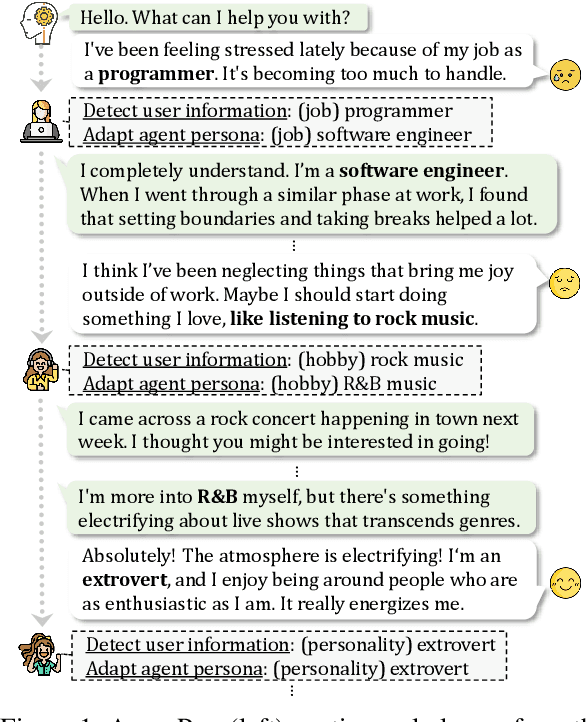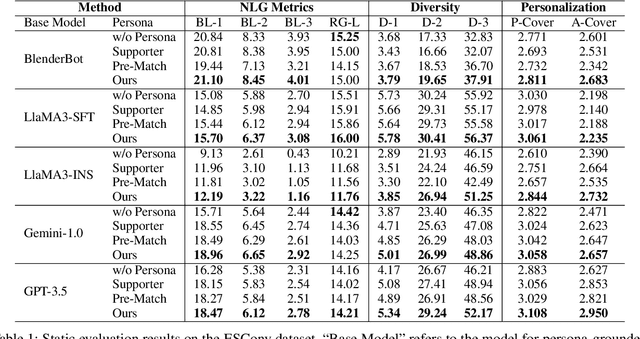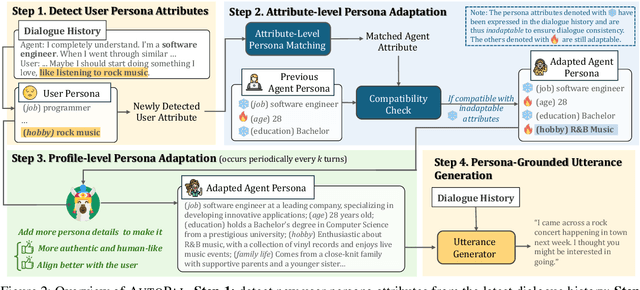Kaishuai Xu
Learning to Align Multi-Faceted Evaluation: A Unified and Robust Framework
Feb 26, 2025Abstract:Large Language Models (LLMs) are being used more and more extensively for automated evaluation in various scenarios. Previous studies have attempted to fine-tune open-source LLMs to replicate the evaluation explanations and judgments of powerful proprietary models, such as GPT-4. However, these methods are largely limited to text-based analyses under predefined general criteria, resulting in reduced adaptability for unseen instructions and demonstrating instability in evaluating adherence to quantitative and structural constraints. To address these limitations, we propose a novel evaluation framework, ARJudge, that adaptively formulates evaluation criteria and synthesizes both text-based and code-driven analyses to evaluate LLM responses. ARJudge consists of two components: a fine-tuned Analyzer that generates multi-faceted evaluation analyses and a tuning-free Refiner that combines and refines all analyses to make the final judgment. We construct a Composite Analysis Corpus that integrates tasks for evaluation criteria generation alongside text-based and code-driven analysis generation to train the Analyzer. Our results demonstrate that ARJudge outperforms existing fine-tuned evaluators in effectiveness and robustness. Furthermore, it demonstrates the importance of multi-faceted evaluation and code-driven analyses in enhancing evaluation capabilities.
Memory-Augmented Multimodal LLMs for Surgical VQA via Self-Contained Inquiry
Nov 17, 2024



Abstract:Comprehensively understanding surgical scenes in Surgical Visual Question Answering (Surgical VQA) requires reasoning over multiple objects. Previous approaches address this task using cross-modal fusion strategies to enhance reasoning ability. However, these methods often struggle with limited scene understanding and question comprehension, and some rely on external resources (e.g., pre-extracted object features), which can introduce errors and generalize poorly across diverse surgical environments. To address these challenges, we propose SCAN, a simple yet effective memory-augmented framework that leverages Multimodal LLMs to improve surgical context comprehension via Self-Contained Inquiry. SCAN operates autonomously, generating two types of memory for context augmentation: Direct Memory (DM), which provides multiple candidates (or hints) to the final answer, and Indirect Memory (IM), which consists of self-contained question-hint pairs to capture broader scene context. DM directly assists in answering the question, while IM enhances understanding of the surgical scene beyond the immediate query. Reasoning over these object-aware memories enables the model to accurately interpret images and respond to questions. Extensive experiments on three publicly available Surgical VQA datasets demonstrate that SCAN achieves state-of-the-art performance, offering improved accuracy and robustness across various surgical scenarios.
Subtle Errors Matter: Preference Learning via Error-injected Self-editing
Oct 09, 2024



Abstract:Large Language Models (LLMs) have exhibited strong mathematical reasoning and computational prowess, tackling tasks ranging from basic arithmetic to advanced competition-level problems. However, frequently occurring subtle errors, such as miscalculations or incorrect substitutions, limit the models' full mathematical potential. Existing studies to improve mathematical ability typically involve distilling reasoning skills from stronger LLMs or applying preference learning to step-wise response pairs. Although these methods leverage samples of varying granularity to mitigate reasoning errors, they overlook the frequently occurring subtle errors. A major reason is that sampled preference pairs involve differences unrelated to the errors, which may distract the model from focusing on subtle errors. In this work, we propose a novel preference learning framework called eRror-Injected Self-Editing (RISE), which injects predefined subtle errors into partial tokens of correct solutions to construct hard pairs for error mitigation. In detail, RISE uses the model itself to edit a small number of tokens in the solution, injecting designed subtle errors. Then, pairs composed of self-edited solutions and their corresponding correct ones, along with pairs of correct and incorrect solutions obtained through sampling, are used together for subtle error-aware DPO training. Compared with other preference learning methods, RISE further refines the training objective to focus on predefined errors and their tokens, without requiring fine-grained sampling or preference annotation. Extensive experiments validate the effectiveness of RISE, with preference learning on Qwen2-7B-Instruct yielding notable improvements of 3.0% on GSM8K and 7.9% on MATH.
Integrative Decoding: Improve Factuality via Implicit Self-consistency
Oct 02, 2024Abstract:Self-consistency-based approaches, which involve repeatedly sampling multiple outputs and selecting the most consistent one as the final response, prove to be remarkably effective in improving the factual accuracy of large language models. Nonetheless, existing methods usually have strict constraints on the task format, largely limiting their applicability. In this paper, we present Integrative Decoding (ID), to unlock the potential of self-consistency in open-ended generation tasks. ID operates by constructing a set of inputs, each prepended with a previously sampled response, and then processes them concurrently, with the next token being selected by aggregating of all their corresponding predictions at each decoding step. In essence, this simple approach implicitly incorporates self-consistency in the decoding objective. Extensive evaluation shows that ID consistently enhances factuality over a wide range of language models, with substantial improvements on the TruthfulQA (+11.2%), Biographies (+15.4%) and LongFact (+8.5%) benchmarks. The performance gains amplify progressively as the number of sampled responses increases, indicating the potential of ID to scale up with repeated sampling.
Large Language Models for Disease Diagnosis: A Scoping Review
Aug 27, 2024Abstract:Automatic disease diagnosis has become increasingly valuable in clinical practice. The advent of large language models (LLMs) has catalyzed a paradigm shift in artificial intelligence, with growing evidence supporting the efficacy of LLMs in diagnostic tasks. Despite the growing attention in this field, many critical research questions remain under-explored. For instance, what diseases and LLM techniques have been investigated for diagnostic tasks? How can suitable LLM techniques and evaluation methods be selected for clinical decision-making? To answer these questions, we performed a comprehensive analysis of LLM-based methods for disease diagnosis. This scoping review examined the types of diseases, associated organ systems, relevant clinical data, LLM techniques, and evaluation methods reported in existing studies. Furthermore, we offered guidelines for data preprocessing and the selection of appropriate LLM techniques and evaluation strategies for diagnostic tasks. We also assessed the limitations of current research and delineated the challenges and future directions in this research field. In summary, our review outlined a blueprint for LLM-based disease diagnosis, helping to streamline and guide future research endeavors.
Evolving to be Your Soulmate: Personalized Dialogue Agents with Dynamically Adapted Personas
Jun 20, 2024



Abstract:Previous research on persona-based dialogue agents typically preset the agent's persona before deployment, which remains static thereafter. In this paper, we take a step further and explore a new paradigm called Self-evolving Personalized Dialogue Agents (SPDA), where the agent continuously evolves during the conversation to better align with the user's anticipation by dynamically adapting its persona. This paradigm could enable better personalization for each user, but also introduce unique challenges, which mainly lie in the process of persona adaptation. Two key issues include how to achieve persona alignment with the user and how to ensure smooth transition in the adaptation process. To address them, we propose a novel framework that refines the persona at hierarchical levels to progressively align better with the user in a controllable way. Experiments show that integrating the personas adapted by our framework consistently enhances personalization and overall dialogue performance across various base systems.
Reasoning Like a Doctor: Improving Medical Dialogue Systems via Diagnostic Reasoning Process Alignment
Jun 20, 2024



Abstract:Medical dialogue systems have attracted significant attention for their potential to act as medical assistants. Enabling these medical systems to emulate clinicians' diagnostic reasoning process has been the long-standing research focus. Previous studies rudimentarily realized the simulation of clinicians' diagnostic process by fine-tuning language models on high-quality dialogue datasets. Nonetheless, they overly focus on the outcomes of the clinician's reasoning process while ignoring their internal thought processes and alignment with clinician preferences. Our work aims to build a medical dialogue system that aligns with clinicians' diagnostic reasoning processes. We propose a novel framework, Emulation, designed to generate an appropriate response that relies on abductive and deductive diagnostic reasoning analyses and aligns with clinician preferences through thought process modeling. Experimental results on two datasets confirm the efficacy of Emulation. Crucially, our framework furnishes clear explanations for the generated responses, enhancing its transparency in medical consultations.
No Two Devils Alike: Unveiling Distinct Mechanisms of Fine-tuning Attacks
May 25, 2024Abstract:The existing safety alignment of Large Language Models (LLMs) is found fragile and could be easily attacked through different strategies, such as through fine-tuning on a few harmful examples or manipulating the prefix of the generation results. However, the attack mechanisms of these strategies are still underexplored. In this paper, we ask the following question: \textit{while these approaches can all significantly compromise safety, do their attack mechanisms exhibit strong similarities?} To answer this question, we break down the safeguarding process of an LLM when encountered with harmful instructions into three stages: (1) recognizing harmful instructions, (2) generating an initial refusing tone, and (3) completing the refusal response. Accordingly, we investigate whether and how different attack strategies could influence each stage of this safeguarding process. We utilize techniques such as logit lens and activation patching to identify model components that drive specific behavior, and we apply cross-model probing to examine representation shifts after an attack. In particular, we analyze the two most representative types of attack approaches: Explicit Harmful Attack (EHA) and Identity-Shifting Attack (ISA). Surprisingly, we find that their attack mechanisms diverge dramatically. Unlike ISA, EHA tends to aggressively target the harmful recognition stage. While both EHA and ISA disrupt the latter two stages, the extent and mechanisms of their attacks differ significantly. Our findings underscore the importance of understanding LLMs' internal safeguarding process and suggest that diverse defense mechanisms are required to effectively cope with various types of attacks.
ICON: Improving Inter-Report Consistency of Radiology Report Generation via Lesion-aware Mix-up Augmentation
Feb 20, 2024



Abstract:Previous research on radiology report generation has made significant progress in terms of increasing the clinical accuracy of generated reports. In this paper, we emphasize another crucial quality that it should possess, i.e., inter-report consistency, which refers to the capability of generating consistent reports for semantically equivalent radiographs. This quality is even of greater significance than the overall report accuracy in terms of ensuring the system's credibility, as a system prone to providing conflicting results would severely erode users' trust. Regrettably, existing approaches struggle to maintain inter-report consistency, exhibiting biases towards common patterns and susceptibility to lesion variants. To address this issue, we propose ICON, which improves the inter-report consistency of radiology report generation. Aiming at enhancing the system's ability to capture the similarities in semantically equivalent lesions, our approach involves first extracting lesions from input images and examining their characteristics. Then, we introduce a lesion-aware mix-up augmentation technique to ensure that the representations of the semantically equivalent lesions align with the same attributes, by linearly interpolating them during the training phase. Extensive experiments on three publicly available chest X-ray datasets verify the effectiveness of our approach, both in terms of improving the consistency and accuracy of the generated reports.
When LLMs Meets Acoustic Landmarks: An Efficient Approach to Integrate Speech into Large Language Models for Depression Detection
Feb 17, 2024



Abstract:Depression is a critical concern in global mental health, prompting extensive research into AI-based detection methods. Among various AI technologies, Large Language Models (LLMs) stand out for their versatility in mental healthcare applications. However, their primary limitation arises from their exclusive dependence on textual input, which constrains their overall capabilities. Furthermore, the utilization of LLMs in identifying and analyzing depressive states is still relatively untapped. In this paper, we present an innovative approach to integrating acoustic speech information into the LLMs framework for multimodal depression detection. We investigate an efficient method for depression detection by integrating speech signals into LLMs utilizing Acoustic Landmarks. By incorporating acoustic landmarks, which are specific to the pronunciation of spoken words, our method adds critical dimensions to text transcripts. This integration also provides insights into the unique speech patterns of individuals, revealing the potential mental states of individuals. Evaluations of the proposed approach on the DAIC-WOZ dataset reveal state-of-the-art results when compared with existing Audio-Text baselines. In addition, this approach is not only valuable for the detection of depression but also represents a new perspective in enhancing the ability of LLMs to comprehend and process speech signals.
 Add to Chrome
Add to Chrome Add to Firefox
Add to Firefox Add to Edge
Add to Edge